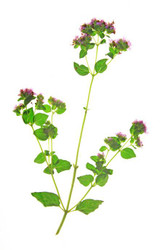Oil of Oregano: Nature’s Antibiotic?
Apr 21st 2021
Posted by Stephanie Chambers
by Stephanie Chambers
Oregano is a common perennial herb that many of us have used to flavor our meals. It is native to the Mediterranean region and to the warmer parts of western and southwestern Eurasia. It also grows in some colder areas, but there it is considered an annual rather than a perennial because it doesn’t survive the winters. There are a number of varieties of it. It has purple flowers and is related to marjoram and sometimes called wild marjoram. Oregano was used by the ancient Greeks for a variety of ailments. It’s said that Hippocrates - the “father of medicine” - often used oregano as an antiseptic.
Oregano Essential Oil or “oil of oregano” is produced via steam distillation of the dried flowers of the plant. It has a strong, distinct smell and is a broad spectrum natural antibiotic. It is fairly aggressive in its ability to kill germs. Even WebMD says taking it for 6 weeks (as advised by your doctor) can kill the parasites Blastocystis hominis (one of the most common human parasites in the world), Entamoeba hartmanni, and Endolimax nana, because clinical studies have shown this to be the case1.
WebMD also says that the herb (not the essential oil) has been shown 2 to reduce high cholesterol when taken after each meal for 3 months. It reduces bad cholesterol (low-density lipoprotein) and increases good cholesterol (high-density lipoprotein) in people with high cholesterol. WebMD says the evidence hasn’t been sufficient to prove its effectiveness for a range of other conditions. However, WebMD allows people to enter comments about it, and people say that they have found it extremely helpful for a range of things like cold sores, sinus infections, post-nasal drip, plantar warts, cold or flu symptoms, coughs, respiratory infections, bedsores, acne, allergies, Candida, and more. Out of 106 reviews, it rates 4.55 out of 5 stars for effectiveness and 4.63 for satisfaction. Some of these reviewers were using the essential oil (internally or external depending on the condition) and others were using it in other forms.
It should be noted that Oregano Oil can be toxic to the liver and other organs if taken internally in high doses (i.e. more than a few drops a day) or over long periods (e.g. more than 3 weeks). It can burn the skin and always needs to be diluted before use. It should not be used during pregnancy.
Some of Oregano Oil’s power comes from its Carvacrol component. The level of Carvacrol varies depending on the growing conditions the plants faced that year. But studies have shown that just using pure Carvacrol itself isn’t as effective as using the plant in its entirety. This is because all the components in the plant create a synergistic effect that far outweighs the effect of any one component. In fact, if the level of Carvacrol is too high, it can burn the skin and need to be diluted even more than normal.
Traditionally, Oregano Essential Oil has been used for a number of other conditions such as fungal nails, psoriasis, athlete’s foot and tonsillitis.
For example, Oregano Oil is much more potent than Tea Tree Oil as a nail fungus remover. It needs to be diluted to 5% in a carrier oil (25 drops per tablespoon). Apply often.
To use it for psoriasis, dilute it to a maximum of 1% in a carrier oil (5 drops per tablespoon) and apply to affected areas. Ideally, you should dilute it with a carrier oil that is also good for psoriasis, such as Avocado Oil.
To use it for athlete’s foot, it has to be diluted to a maximum of 3-5% in a carrier oil (15-25 drops per tablespoon) and applied to affected areas.
To use it for tonsillitis, dilute it to 2% in sesame oil (10 drops per tablespoon) and gargle. Do not swallow.
I have used Oregano Oil for a fungal fingernail. But to be honest, I used it (diluted as recommended above) each morning for a couple of weeks and then, because I was busy moving house and so on, stopped applying it. Maybe I should have been applying it twice or more a day. I must start applying it again. My nail does seem to be improving a little, but these sorts of fungal infections, in my experience, take a while to go away. I also used some of it when some spots of psoriasis threatened to be reappearing, and applying it on each spot (diluted as recommended above) for a few days seemed to help them disappear.
Have you used Oregano Oil? What did you use it for? How did you use it and what were the results? We would love to hear your experiences with it, so please comment below.
Sources:
1 http://www.ncbi.nlm.nih.gov/pubmed/10815019
2 http://www.ncbi.nlm.nih.gov/pubmed/19094443
Disclaimer: The statements made on this page have not been evaluated by the U.S. Food and Drug Administration (FDA). They are not intended to diagnose, cure or prevent any disease. If a condition persists, please contact your physician or healthcare provider. The information provided is not a substitute for a face-to-face consultation with a healthcare provider, and should not be construed as medical advice.
Original Published: 2016-01-14 / Last Modified: 2021-10-11

